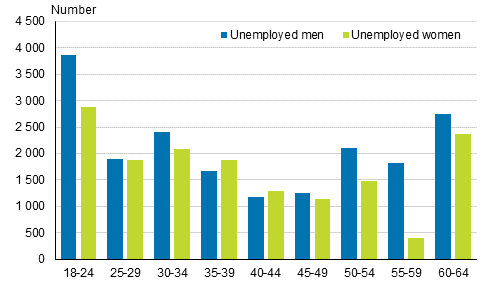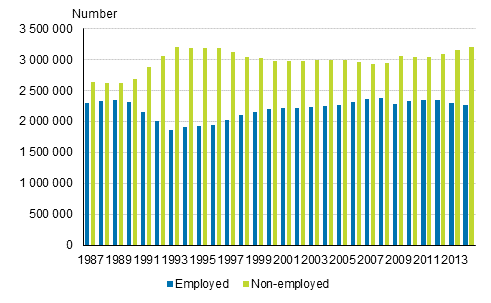Published: 19 February 2016
Unemployment of persons aged under 25 grew by 15 per cent in 2014
According to Statistics Finland's employment statistics, the number of unemployed persons grew by ten per cent in 2014 from the previous year. The number of unemployed increased most in the age group of persons aged under 25. The number grew in all age groups. The number of employed persons fell by one per cent from 2013. The economic dependency ratio weakened by four people from the previous year; in 2014, there were 141 non-employed persons per one hundred employed persons.
Change in the number of unemployed persons by sex and age in 2013 to 2014

Share of employed persons in working-age population 68 per cent in 2014
There were 2,249,000 employed persons aged 18 to 64 at the end of 2014. Compared to the year before, the number went down by 29,000 (-1%). The share of employed persons among the population in the same age group was 68 per cent in 2014, which was 0.6 percentage points lower than one year previously.
Examined by sex, the share of employed persons among the population aged 18 to 64 was 66.4 per cent for men and 69.7 per cent for women. The fall from the year before amounted to -0.7 percentage points for men and to -0.5 percentage points for women.
Number of unemployed increased least in the age group of persons aged 55 to 59
According to the employment statistics, there were 362,000 unemployed persons of working-age at the end of 2014, which was over 34,000 (10%) more than one year earlier. At the end of 2014, there were 210,700 unemployed men and 151,500 unemployed women. The number of unemployed men grew by ten per cent (19,000) and that of unemployed women by 11 per cent (15,000) from 2013.
Examined by age, the number of unemployed persons went up from the year before most in the age group of those aged 18 to 24. The number of unemployed persons aged under 25 increased by over 6,700, which is 15 per cent more than one year earlier. The number of unemployed women grew in the age group by nearly 19 per cent from 2013. The number of unemployed persons aged 30 to 34 and 60 or over also went up by 13 per cent from 2013.
The number of unemployed increased least in the age group of women aged 55 to 59. The number of unemployed persons in the whole age group grew by 2,200, which was five per cent more than in 2013. There were two per cent more unemployed women aged 55 to 59 and eight per cent more unemployed men than in the year before.
Economic dependency ratio weakened
The economic dependency ratio weakened from the previous year. In 2014, there were 141 non-employed persons per one hundred employed persons, while one year earlier the figure was 137. In the period 1987 to 2014, the dependency ratio was highest in the year of recession 1993 (172) and lowest in 1989, when there were 112 non-employed persons per one hundred employed persons. (Appendix table 1.)
The economic dependency ratio is calculated by dividing the number of unemployed, pensioners and other inactive population by the number of employed persons and by multiplying the figure obtained by one hundred. A fall in the economic dependency ratio is thus regarded as positive and a rise as negative. In addition to variations in economic cycles and development of employment, the economic dependency ratio is affected by the birth rate, population structure and migration.
Main type of activity of working-age population in 1987 to 2014

The number of unemployed persons was biggest in 1993, when over 531,000 persons of working age were unemployed. After the 1990s the number of employed persons was at its highest in 2008, when there were over 2.36 million employed persons.
Regional differences in the economic dependency ratio are large. In 2014, the dependency ratio was clearly lowest in Åland (100), where the dependency ratio improved from one year ago (106). In 2014, the economic dependency ratios were highest in Kymenlaakso (168), Etelä-Savo (168), North Karelia (171) and Kainuu (179). The economic dependency ratios weakened between 2013 and 2014 in all regions, except for Åland. The economic dependency ratio deteriorated most in Kymenlaakso, Satakunta and Päijät-Häme. (Appendix table 2.)
Source: Employment Statistics, Statistics Finland
Inquiries: Laura Lohikoski 029 551 3396, info@stat.fi
Director in charge: Jari Tarkoma
Publication in pdf-format (218.1 kB)
- Tables
-
Tables in databases
Pick the data you need into tables, view the data as graphs, or download the data for your use.
Appendix tables
Updated 19.2.2016
Official Statistics of Finland (OSF):
Employment [e-publication].
ISSN=2323-6825. Background information on unemployed persons 2014. Helsinki: Statistics Finland [referred: 12.12.2025].
Access method: http://stat.fi/til/tyokay/2014/03/tyokay_2014_03_2016-02-19_tie_001_en.html

